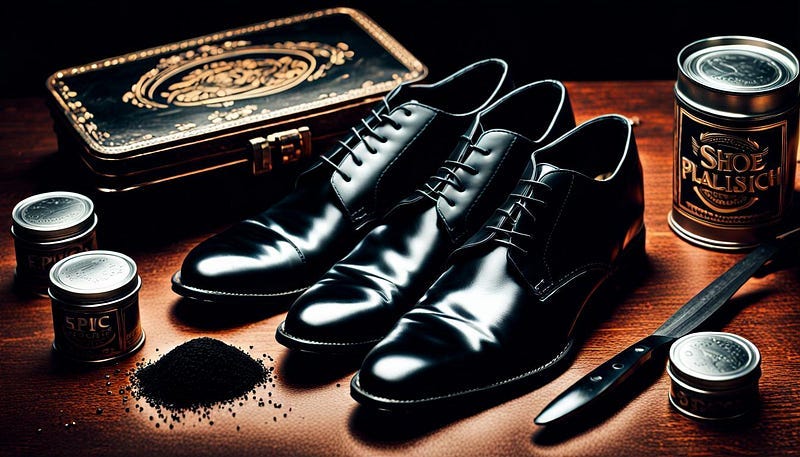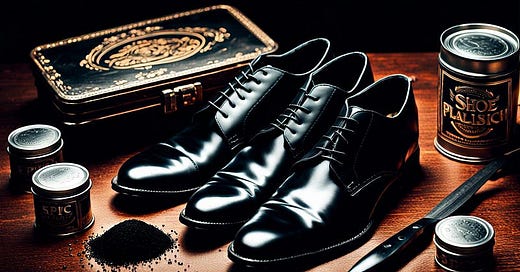Using conditioners and polishes

I have always bought and maintained a few pairs of formal dress shoes, with genuine good quality leather, and although expensive at the time, with good care they will last a long time and will look dressy even after many years of wear.
As well as as being regularly cleaned and polished, they should also be treated occasionally with a good leather conditioner or balm. This is necessary because leather, being a natural material, can dry out and the fibres may loss their natural oils, allowing the leather to stiffen and crack.
Do you condition leather before or after polish?
Maintaining the quality of your leather items involves various steps, with conditioning playing a crucial role. However, the question arises — should you condition leather before or after polishing? I’ll give you some of the reasons behind each, and provide recommendations for achieving the best results.
Types of leather conditioners and polishes
Before getting into the debate, it’s important to understand that leather conditioners and polishes come in different forms. Some products combine conditioning oils and polishing agents, performing both tasks in one step. Others are stand-alone products, necessitating separate use for conditioning and polishing.
Why condition leather before polishing
Moisturises the leather fibres
The primary reason to condition leather before polishing is to moisturise the leather fibres. Failure to do so can lead to dryness, making the leather more prone to cracking and breaking. Conditioning acts as a preventive measure against these issues.
2. Keeps the leather soft And supple
Soft and supple leather not only looks better but also lasts longer. Conditioning before polishing helps maintain the leather’s flexibility, preventing it from becoming rigid or hard, which can be challenging to polish and more susceptible to damage.
3. Retains or preserves essential oils
Leather contains essential oils that contribute to its lubrication. Conditioning before polishing helps preserve these oils, ensuring the leather remains healthy and preventing it from drying out and cracking over time.
4. Conditioning replenishes lost oils
Over time, leather loses its natural oils, leading to dryness and potential cracking. Conditioning before polishing provides a much-needed oil treatment, replenishing lost oils and keeping the leather in good condition.
Why polish leather after conditioning
Gives leather a better protective coating
Applying polish to leather creates a protective barrier against elements like water and stains. This helps safeguard the leather and prolong its lifespan.
2. Ensure the polish adheres to the leather surface
Conditioning before polishing ensures a strong adherence of the polish to the leather surface, creating a more durable and long-lasting protective coating.
3. Polishing after helps to trap the conditioning oils in the leather
Polishing after conditioning helps trap conditioning oils in the leather, contributing to its softness and suppleness.
4. Helps to create a water-resistant barrier
Polishing post-conditioning adds an extra layer of water resistance, making your leather items more resilient on wet days.
5. Gives the leather a more uniform finish
Polishing after conditioning allows you to achieve a more uniform and professional finish, enhancing the overall appearance of your leather items.
Consequences of conditioning leather after polishing
If you ignore the proper order of cleaning, conditioning, and polishing, several negative consequences may arise over time:
• The conditioner may not be absorbed effectively.
• Polish may not adhere properly, leading to a tacky finish.
• Polish may become brittle over time, affecting its protective capabilities.
• The leather may lose its natural shine and become susceptible to stains and water damage.
The best way to condition and polish leather items
To ensure the longevity and quality of your leather items, follow this correct order:
1. Clean your leather: Use mild soap and water or a dedicated leather cleaner to clean the leather thoroughly.
2. Condition the leather: Apply a thin layer of quality leather conditioner, allowing it to soak in for several minutes.
3. Polish the leather: Use a high-quality leather polish to create a protective barrier and achieve a shining, lustrous finish. A buffing cloth can help achieve a smooth, polished look.
Final thoughts
Maintaining the quality of your leather items requires a systematic approach. By cleaning, conditioning, and polishing in the correct order, you can ensure your leather stays in optimal condition.
Avoid the negative effects of conditioning after polishing by following these steps, and enjoy your well-preserved leather items for years to come.
I hope this article proves helpful in your leather care routine.




